I want to refer to a recent paper appearing in the Journal of Equine Veterinary Science, which was written by a group of non-scientists who were involved in a study to look at the repeatability of SMS (Society of Master Saddlers) qualified saddle fitters’ observations during static saddle fit. What this means basically, is how much agreement was there between allegedly similarly trained and certified saddle fitters when determining how well and whether a saddle fit.
In the synopsis/abstract it states the purpose was to see the level of matching there was during assessing fit along the guidelines as taught by the SMS. There have been no recorded studies to date to determine any level of conformity between professionals working in this field. At the end of the day, there was substantial agreement of the 20 volunteers ‘tested’ only when regarding wither clearance (which is pretty basic given that we have all learned that 2-3 fingers is recommended at the top of the withers – but interestingly enough, no consideration was given to the necessary clearance at the side of the withers, which is something I have always advocated as important). Moderate agreement was given to the position of the billets as they related to the ‘girth groove’ and regarding panel contact. Only minimal consensus was given to the extremely important areas of tree width (nothing mentioned about angle!) and saddle length. The final recommendation given was that criteria for fit should be standardized, which is probably why the SMS has announced that it would be revamping its saddle fitter training in the next year. (I have offered my involvement in this crucial next step – but I’m still waiting for my invitation to participate.)

The paper further confirms that legally anyone can fit, adjust, or sell saddles in the UK (and probably anywhere in the world for that matter) without holding any formal qualifications. It further states that England is the only country which offers an industry recognized qualification in saddle fitting – as provided by the Society of Master Saddlers. (This is somewhat disingenuous, as Germany has a somewhat more detailed apprenticeship than even the SMS). SMS qualification comes after a 4 day (!) course. Hardly sufficient to even get your feet wet in the field of saddle fitting, in my opinion – we at Saddlefit 4 Life don’t certify qualified Saddle Ergonomists until approximately 6-8 months of training (including extensive forays into human and equine anatomy and biomechanics) and practical experience (doing many saddle fit evaluations independently – correctly and completely!)

Jochen Schleese pointing to the last supportive rib of this horse’s saddle support area (SSA). This is a critical point to which the saddle should not sit past to ensure the horse’s comfort and freedom of movement. This particular saddle sits well within the bounds of this particular horse’s SSA.
Furthermore, this study only dealt with static fit – with rather significant deviations in ‘opinions’. Let’s not even think what including dynamic fit would have done to the results! I agree that there could be a slight level of subjectivity when assessing saddle fit, however, there are certain logical anatomical requirements that need to be met by any saddle that is intended to fit a particular horse – and these should not be up to debate. The anatomies of horse and rider have certain commonalities which simply cannot be argued away, and need to be considered in saddle fit and should be standardized in a common ‘saddle fitting language’ that is taught globally.

Jochen Schleese’s chalk drawing on a horse indicating the ideal Saddle Support Area while also indicating the critical area (in red) to avoid as any pinching in this area will result in reflexes that will inhibit the horse’s forward movement and comfort.
Scientific facts are facts, as the anatomy of the horse and the anatomy of the saddles are facts. Saddle fitting is science and art. Horseback riding is an art, there are principal rules, and yet every rider interprets and rides their horse the way they feel is correct. There will always be interpretations and differences in skill sets and experiences, but if the basics are the same, this level of disparity should not occur – especially since these saddle fitters were all presumably taught under the same curriculum of the SMS. I was recently told that the British particularly are shy when asking their equine professionals about their credentials; it’s more a matter of trust than ‘control’. I think that the health of your horse is more important than the niceties of misplaced diplomacy. Ask the questions that need to be asked!
1 Investigation looking at the Repeatability of 20 Society of Master Saddlers Qualified Saddle Fitters’ observations during static saddle fit. Russell Guire, Renate Weller, Mark Fisher, Jo Beavis. Journal of Equine Veterinary Science 2017
~ Jochen Schleese CMS, CSFT, CSE, courtesy of Saddlefit 4 Life
©2017 Saddlefit 4 Life® All Rights Reserved

